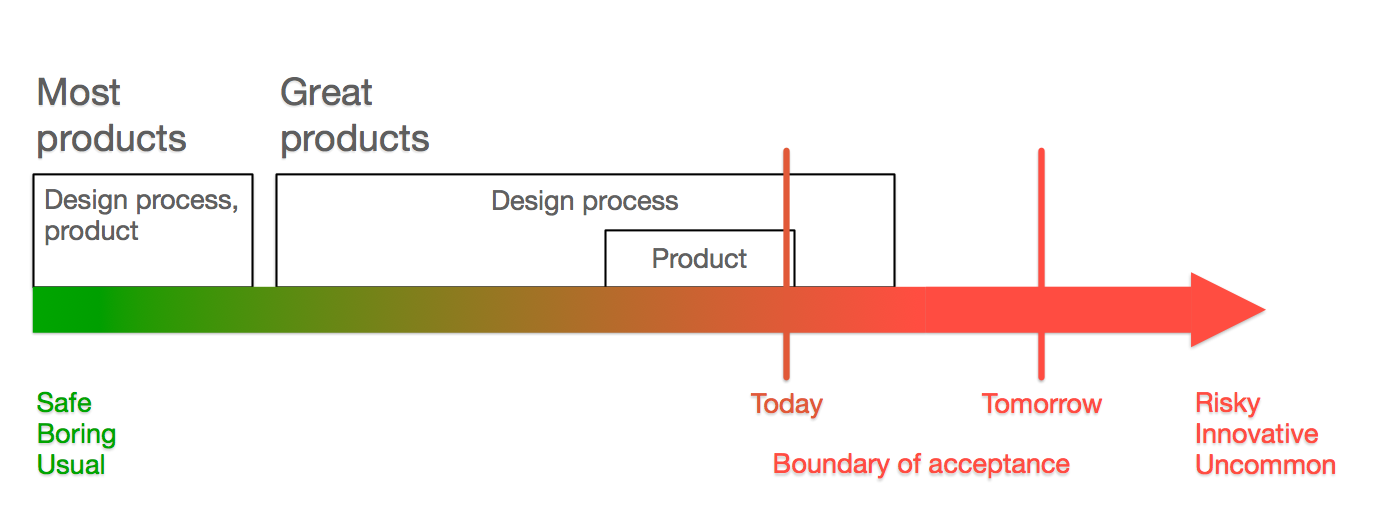How great design embraces the boundary of acceptance
July 30, 2011
I didn’t invent this, but I bet that most people in the world, or even many designers, have not really thought of products or design in these terms. My inspiration to think of design in these terms came from my Carnegie Mellon instructor John Zimmerman, and I’ve found this to be a very useful and daily applicable theory.

There’s this axis. At one end, you have “Safe, boring, and usual”. Good design is expensive, and most of the world is cheap. So there is always a market for tried, true, and cost-effective things. There’s no real design process to making any of these: someone just throws something together, to the best of their knowledge, but without consciously thinking about design, or perhaps under too much pressure to do anything really creative.
Staying in the safe zone means either applying readymade templates or patterns, or just plain copying someone else’s work. There is no separate inquiry or design process, it’s the same as the final product.
At the other end of the axis is “Risky, innovative, and uncommon”. This is “out there”. At the extreme are unacceptable things in the current culture and context. This always depends. For example, going to a bank in bikinis is uncommon if you are the customer and unacceptable if you’re the employee, but going to a beach in bikinis is fine, even if the same persons are involved.
If you are a good designer, you understand this axis for whatever you are building or making, and your design process covers a wide spectrum on it. It doesn’t matter where exactly you start, but through the process, it’s important to cast a wide net to understand where exactly the boundary acceptance lies.
Some of the work will necessarily exceed this boundary. This is, to quote John Z, because “you need to test the boundaries to understand where they are”. Even if you understand the safe-risky axis, the boundary for a given product or version is a moving target and impossible to determine in advance.
If you’re a great designer, you know that testing this boundary, and having work rejected because it’s too “out there” is nothing to be afraid of. Indeed, this can be the most fun and rewarding part of the work. You can often see the future as you are going through the process: as others start copying innovative work, what was once risky becomes safe and accepted, and the boundary of acceptance moves forward. What was once beyond the boundary, is suddenly within reach. If you then have previous work standing by, you just take it off the shelf, say “see, I told you”, and roll it out.
However much it is fun to test the boundaries, the final product is mostly within the safe zone. Notice, though, that there is a slight part of it beyond the boundary. In case of digital products, these are the features that you think “nobody will understand”, “this is stupid”, “the old version was better”. Sometimes you’re right, but often, the design is nudging the boundary forward.
Design here doesn’t mean any particular discipline like interaction, visual, service, industrial, interior or whatever other kind of design. You can apply exactly the same model to starting new businesses. Entrepreneurs are nothing more than designers of businesses. All great innovations are born, and new industries are started, because someone correctly identified the boundary of acceptance and built their business around it. What follows is simply commoditization and competition on cost—until someone again pushes the boundary.
In the grand scheme of things, this is a model for all human progress. But don’t let this scare you. It’s a very practical approach, applicable daily to even the most tiniest, trivial things. It has helped me in producing better work.